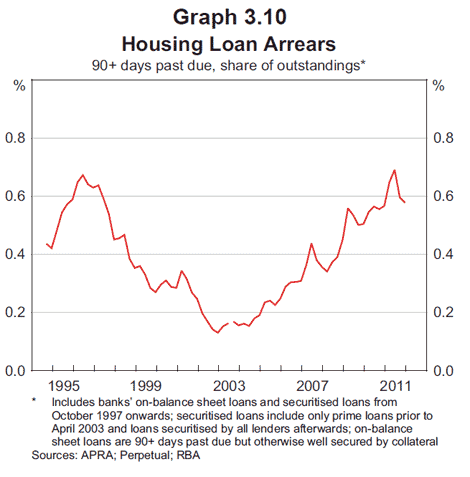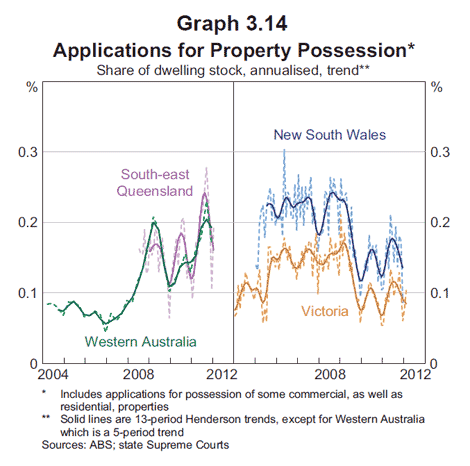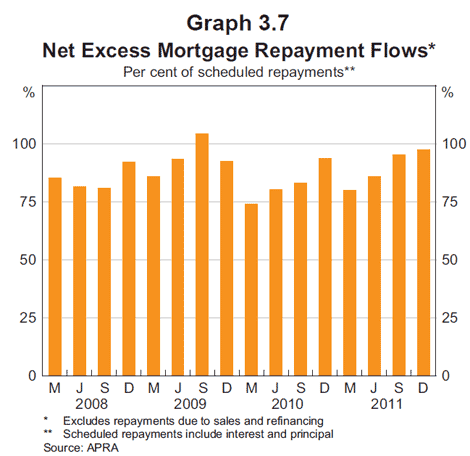Australian home loan arrears are falling (not increasing): Christopher Joye

In contrast to the sometimes hysterical media coverage yesterday of a minor Fitch report claiming that Australian home loan delinquencies had risen over the second half of 2011, the RBA’s Financial Stability Review released today corrects this error and finds quite the opposite.
The difference between the two reports is explained by what they cover. The RBA’s analysis includes all home loans on bank balance-sheets plus “securitised” loans: more than $1.2 trillion worth in total. In contrast, Fitch’s research only covers securitised loans, which amount to less than $100 billion. To be clear, these loans are included in the RBA’s sample, but represent less than 10% of the total.
The RBA concludes that total home loan arrears in Australia declined – not increased (as Fitch argued) – in the second-half of 2011. Specifically, the RBA comments:
“The arrears rate for housing loans (on banks’ domestic books plus securitised housing loans) declined to 0.6% in December, from 0.7% in mid-2011. The non-performing rate for credit cards has also improved, falling from 1.4% in June 2011 to 1.2% in December, while the rate for other personal loans has been broadly unchanged since mid-2011 at around 2%.”
The RBA’s chart below shows that while home loan arrears have risen steadily since their nadir in 2003, they remain no higher than they were in the mid-1990s. The drop-off in delinquencies in the latter half of 2011 is clearly visible at the end of the time-series.

The improved debt-servicing performance of Australian borrowers was also reflected in a trend decline in applications for repossessions of homes across most Australian states. The RBA has been building up its analysis of foreclosures, and the latest Financial Stability Review presents the best parsing yet. The second chart below illustrates trend changes in foreclosures for New South Wales, Victoria, Western Australia, and south-east Queensland through to early 2012. In this context, the RBA observes:
“Possession rates have generally either stabilised or improved in most other states. Bankruptcy rates have [also] broadly fallen across states since 2009, although less so in Queensland and Western Australia. Overall, though, the number of households whose financial difficulties have deteriorated to the extremes of bankruptcy or lender property possession is very low in absolute terms.”

Another unique RBA data-set released today is the share Australian borrowers who are repaying their home loans more quickly than what is actually required by their lenders (under their “amortisation schedules”). The RBA’s research reveals that these so-called “excess repayments” increased significantly over the course of 2011, which in turn implies that household stress was on the decline (refer to the third chart below):
“Many borrowers are repaying substantially more than required: data from lenders suggest that the rate at which borrowers were making excess repayments on their mortgages increased over 2011. Total excess repayments were roughly the same as required repayments in the December quarter 2011, up from about 80%in the March quarter.”

Finally, the RBA confirms my recent arguments about advances in home owner affordability, noting, “At the national level, the ratio of dwelling prices to income has fallen over the past year, and is below the average of the past decade, while rental yields have begun to pick up, assisted by stronger rental growth as well as lower prices.”
It will be fascinating to see how much media prominence is given to the RBA’s findings vis-à-vis the coverage yesterday of Fitch’s report.
Christopher Joye is a leading financial economist and a director of Rismark International and Yellow Brick Road Funds Management. The above article is not investment advice.